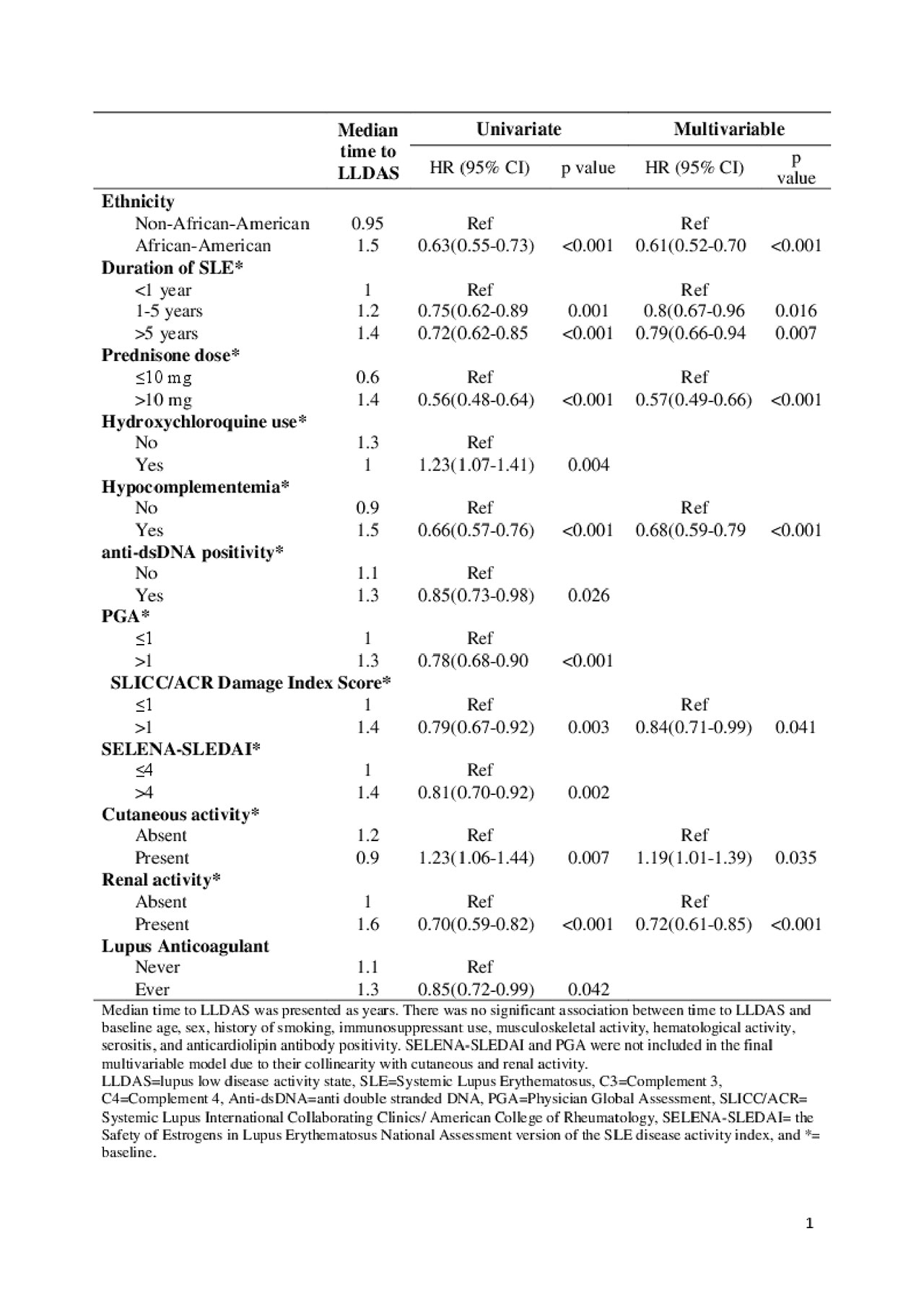Session Information
Session Type: Poster Session (Tuesday)
Session Time: 9:00AM-11:00AM
Background/Purpose: Lupus Low Disease Activity State (LLDAS) is a potential treat to target goal in systemic lupus erythematosus (SLE). It is well established that SLE patients who were in LLDAS for more than half of the observation period have a lower risk of new damage. The presentation and course of SLE is affected by ethnicity. African-American SLE patients are known to experience more severe SLE and, more chronic disease activity pattern. LLDAS in African-Americans has not been fully elucidated. In this study, we determined the time to LLDAS and predictors of time to LLDAS in a cohort with both Caucasian and African-American representation.
Methods: This analysis was based on cohort data from its inception until January, 2019. A total of 2,512 SLE patients, diagnosed according to the SLICC or ACR classification criteria, were included. We applied LLDAS (1), which was defined as a SELENA-SLEDAI score of ≤4 with no scores for the renal, central nervous system, cardiopulmonary, vasculitis, fever, no hemolytic anemia or gastrointestinal activity, no increase in any SELENA-SLEDAI component since the previous visit, a PGA of ≤1, and a prednisone dose of ≤7.5 mg/day. Immunosuppressant and hydroxychloroquine treatment were allowed for LLDAS. Patients were grouped according to LLDAS status at cohort entry. Those who did not satisfy LLDAS at cohort entry were analyzed prospectively. The Kaplan Meier approach was used to estimate the distribution of time to LLDAS and probability of patients achieving LLDAS after cohort entry, censoring patients who had a gap of 7 or more months in their follow-up time or who dropped out of the study before attaining LLDAS. Cox regression was used to identify patient characteristics that were associated with time to LLDAS.
Results: 1086 (43.2%) patients were in LLDAS at the first cohort visit. The probability of LLDAS attainment within one year was 52% for Caucasians, and 36% for African-Americans. Among those with renal involvement, the estimated probability of achieving LLDAS within one year was 33% (Figure 1). The median time to LLDAS was 1.1 years. In multivariable models, African-American ethnicity, baseline prednisone >10 mg daily, baseline hypocomplementemia, baseline damage, and baseline renal activity remained significant predictors of longer time to attain LLDAS, while disease duration < 1 year and cutaneous activity were associated with earlier attainment (Table 1).
Conclusion: We demonstrated the achievability of LLDAS in both African-Americans and Caucasian patients, supporting the validity of LLDAS in multiple ethnicities. The time to LLDAS was longer in African-American SLE. Characteristics of African-American SLE such as renal activity and hypocomplementemia were also independent predictors of slower attainment of LLDAS. These findings point to the need to include African-American SLE patients in both clinical and pharmaceutical research, as we cannot generalize from studies from Europe and Asia.
To cite this abstract in AMA style:
Babaoglu H, Li J, Goldman D, Magder L, Petri M. Time to Lupus Low Disease Activity State: Role of African-American Ethnicity [abstract]. Arthritis Rheumatol. 2019; 71 (suppl 10). https://acrabstracts.org/abstract/time-to-lupus-low-disease-activity-state-role-of-african-american-ethnicity/. Accessed .« Back to 2019 ACR/ARP Annual Meeting
ACR Meeting Abstracts - https://acrabstracts.org/abstract/time-to-lupus-low-disease-activity-state-role-of-african-american-ethnicity/


